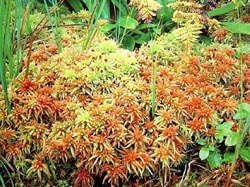
A research group led by Prof. Gao Qian (Chien Gao) from the CAS Shenyang Institute of Applied Ecology was recently awarded a first prize in natural science of Liaoning Province in recognition of its many years of bryophyte studies. The award was conferred by S&T authorities of the northeast China's province.
The CAS group has scored achievements in studies on various aspects of bryophytes ranging from their taxonomy, flora, genetics, spore and pollen, system development, ecology and physiology. The work has been supported by the National Natural Sciences Foundation of China, Ministry of Science and Technology, CAS, and local governments throughout the country. It also carried out cooperation and exchanges with overseas institutions.
For many years since its implementation, the scientists went on fieldtrips and conducted specimens studies in China's 29 provinces, municipalities and autonomous regions (including Hong Kong and Taiwan) as well as Europe, America and other Asian countries.
The researchers have attained innovative results by adopting modern technology of electronic microscopy and computer-aided analyses. As result of their arduous and enduring devotion, they edited or co-edited 21 monographs, including China's first flora of native species of Hepaticae and Musci (in the corpus's Vol. I and Vol. IX respectively), China's first
Moss Flora of China in English and more than 150 research papers in prestigious journals both at home and abroad.
In the taxonomic studies of the moss flora, they succeeded in discovering three families new recorded to China, 115 new species or composite species, three new genera and 30 genera, 531 species new recorded to China. All of these new findings greatly enrich the floral fecundity both in China and in the whole world as well. Also, the research feat provides convincing disciplinary evidences for furthering human understanding of the moss flora's composition, origin, phylogenic evolution in China. Among the 21 monographic works, 12 were chief-edited and nine were compiled by the project's scientists, marking the latest taxonomic developments in the world today. Their research takes the lead both at home and abroad, becoming classics in the international community of bryologists.
In the study of the spore-transferring organs in mosses, for instance, the CAS scientists revealed their main morphologies and responsive structures, strongly proving that mosses originate from green algae and unveiling the related evolutionary processes. They suggested a new evolutionary tree based on families for the flora. Among domestic researchers, they first introduced numerical analysis into the research of bryophyte ecology, including a penetrating probe into the distributive patterns of moss populations and their relationship with their environmental factors and ecological functions in northeast Chinese forests. In the applied research, they took mosses as the pollution indicators and by using the latter, they explored the industrial contaminants in the urban districts of the heavy industry centers of Liaoning Province such as Anshan and Fushun cities and estimated the impacts of "acid rain" in southwest China. Based on this, they put forward a system for rating a city's polluted degrees. In the comprehensive exploitation of bog moss, their work is noted for its fruitful and rewarding returns both socially and economically and by now, the latter have been popularized to medicine, forestry and agriculture.
By indexing the database of the CSCD, the data from the project's monographs have been quoted for more than 340 times by part of the research papers and monographic works and cited by SCI for more 140 times during the period from 1989 to 2001.





